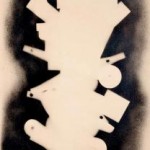Untitled
1963 (SOLD)
Spray enamel on canvas
35 x 28 inches (88.9 x 71.1 cm)
Signed and dated ‘David Smith 2-4 1963’ lower right; stamped with the Estate of David Smith stamp and numbered ‘75.63.25’ verso
Ex-collection:
The estate of the artist
Knoedler Contemporary Art, New York
Private collection until the present
Exhibitions:
New York, Knoedler Contemporary Art, David Smith: Paintings, April-May 1976 (illustrated in color on cover of exhibition announcement).
About the Painting :
“I belong with painters, in a sense; and all my early friends were painters because we all studied together. And I never conceived of myself as anything other than a painter because my work came right through the raised surface and color and objects applied to the surface. Some of the greatest contributions to sculpture of the 20th century are by painters. Had it not been for painters, sculpture would be in a very sorry position. Some of the greatest departures in the concept of sculpture have been made by Piscasso and Matisse. Painting and sculpture aren’t very far apart” (David Smith quoted in David Smith by David Smith: Sculpture and Writings, London, 1968, p. 106).
David Smith was an obsessive producer. Although he is best known today for his sculpture, he was a talented draftsmen and painter as well. While Smith sought to make drawings in space with his sculptures, his paintings are heavily dependent upon the exploration of negative space and the absence of implied mass. Although Smith certainly created some paintings as studies for sculptures, most of his paintings like Open Window are meant to stand alone.
Smith’s paintings are some of his purest expressions. Smith was quick to admit that sculpture was a difficult medium with which to pursue his Abstract Expressionist goals. The laborious process of assembling metal parts through welding and casting could easily squash the spontaneity and dynamism Smith sought. Drawing and painting, however, were the forms with which Smith could immediately put forth his ideas. He said, “the sculptor…works in media slow to take realization. And when the original creative impetus must be maintained during labor, drawing is the fast-moving search, which keeps physical labor in balance” (David Smith quoted in G. McCoy, David Smith, New York, 1973, p. 137).
As one of the few artists who could successfully translate the painterly tenets of Abstract Expressionist into sculptural form, it is no surprise that his paintings were equally unique in their conception and execution. He did not rely on “action” painting like his peers Jackson Pollock and Franz Kline, but instead created dynamic and spontaneous compositions on par with the best Abstract Expressionist canvases using metal parts and studio detritus as stencils. Smith utilized his all encompassing perspective to create works of enormous emotional resonance.
“Art has its traditions, but it is a visual heritage. The artist’s language is the memory from sight. Art is made from dreams, and visions, and things not known, and least of all from things that can be said. It comes from the inside of who you are when you face yourself. It is an inner declaration of purpose, it is a factor which determines artist identity” (David Smith quoted in Ibid, p. 147).


 A Sketch for a Sculpture (Raven Series)
A Sketch for a Sculpture (Raven Series)
 Untitled (Green/Purple)
Untitled (Green/Purple)
 Dancer
Dancer
 Untitled
Untitled
 Untitled
Untitled